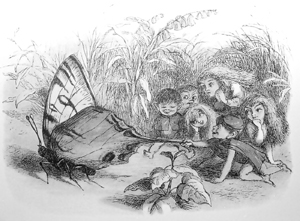By Joanne Nesbit
News and Information Services

Memories just bounce off the walls when viewing the display of children’s books, “From Potter to Potter,” at the Hatcher Graduate Library. From classics to notable authors and book awards, the exhibition’s colorful collection of books, their jackets, and their illustrations conjures memories of summers past when a book could provide transportation to other places and other times.
“The themes of children’s classics, like the themes of adult fiction, are valid through generations,” says Denise Schoene, resource coordinator for the Social Sciences Library.
Why does a university library have a children’s book collection? Originally, the collection was organized to support the University’s studies in elementary education and library sciences. Through purchases and donations from private collections, the holdings have grown and evolved into an extensive and expansive collection numbering into the thousands and include historical works, works available for circulation and those designated to the University’s “Special Collections.” Studies can be made by considering illustrators, bindings, printers, correspondences and original artwork, as well as authors.
Early children’s books began with a flurry of publications in England in the mid-1700s. Innovations in the printing press made publishing cheaper and allowed more illustrations, explains Marilene DeRitis, a technical library assistant. A 1742 publication of a rhyming alphabet encouraged children to cut out the letters. The first collection of nursery rhymes appeared in 1744, the same year John Newbery published the Little Pretty Pocket Book, which set a standard for publishing popular children’s books with its great commercial success.
The exhibition also includes some modern books, and Schoene notes that, “The importance of reading as a key to scholastic success is one of the catalysts to a broadened and enhanced children’s book market.” Schoene also attributes some of the success of children’s books to various themes such as diversity, problems of modern life, interesting non-fiction, as well as film tie-ins, and books in the form of toys.
“The concept of what is suitable for children has changed quite a bit,” Schoene says. “But the idea is not so different—there should be books for children that entertain and educate. With this has come the attempt to sell books to children as consumers, as parents probably are aware.”
Known as an author of adult novels, short stories, essays and poetry, John Updike also wrote an award-winning children’s book and adapted for children other works such as Shakespeare’s A Midsummer Night’s Dream, and Wagner’s The Ring. New Yorker cartoonist William Steig also has written for children, writing and/or illustrating nearly 30 children’s books for which he has received numerous awards, including the Caldecott Medal.
From the beginning of the 20th century until well into the 1960s and ’70s, hundreds of popular juvenile mysteries and adventure stories were published each year by Carolyn Keene and Franklin W. Dixon, as well as other writers from the Edward Stratemeyer Author Syndicate. The authors were paid about $125 per volume, notes Librarian Rebecca Dunkle. Writing under collective pseudonyms, they produced such series as Tom Swift, the Hardy Boys, Nancy Drew and the Bobbsey Twins, among many others. Updated Hardy Boys and Nancy Drew series are still being produced today.
John Steptoe was amazed that there were no books being written in the dialogue of Black children. He changed this with his first book Stevie, published when Steptoe was only 19. Before his death at age 38, Steptoe wrote and illustrated more than a dozen well-liked and award-winning children’s books.
What makes a popular or award-winning children’s book? Most awards recognize either contributions to literature or illustration, says Gene Alloway, a senior librarian. “The Randolph Caldecott Medal, first awarded in 1938, is presented for illustration in the United States,” he says, “while the John Newbery Medal is given for literature.”
Other U.S. awards include the Coretta Scott King Award for books promoting the American dream, the National Book Award for Young People’s Literature, the Pura Belpre Award for Latino literature and the Jane Addams Book Award for peace. The Carnegie Medal is given for a children’s book by an English author, and the Kate Greenaway Medal for children’s picture book illustration in the United Kingdom.
Michigan awards two prizes each year. The Thumb’s Up Award is presented by the Michigan Library Association to single out excellence and uniqueness in young adult literature. The other award, begun in 1999, is the Mitten Award, with recipients determined by children’s librarians of the Michigan Library Association.
“Potter to Potter” will continue through August and is located in the north entrance to the Graduate Library. The exhibition can be viewed 8 a.m.–midnight Monday–Thursday, 8 a.m.–10 p.m. Fridays, 10 a.m.–6 p.m. Saturdays and 2 p.m.–midnight Sundays.

